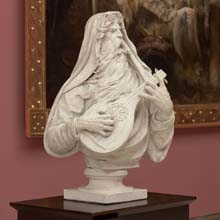

material: plaster
dimensions: 96 × 76 × 67 cm
description: At the time when Poland was deprived of its independence, lyrists and wajdelotas [bards-prophets] were a living treasury of national identity contained in tales, songs and legends. They constituted an inexhaustible source of knowledge about the nation’s history, beliefs, tradition and culture as well as its heroes and their memorable achievements. Disseminated in villages and cities, handed down from generation to generation, they were preserved in oral tradition, more durable than books and artefacts. Romantic literature, which invested songs with the saving power and significance equal to deed, created a number of model figures of patriotic-Tyrtaean bards and preserved them in the common consciousness of Poles. One of the most excellent examples is wajdelota Halban in "Konrad Wallenrod" [Konrad Wallenrod] by Adam Mickiewicz. The sculptress depicted him, according to the description provided by the poet, as an old man with a long beard, wearing a loose coat, whose face signifies seriousness, wisdom and experience. He is spinning a tale, accompanying himself on the lute. The work combines the poetics of a Romantic subject with the realism of treatment and excellent academic technique. Wacława Milewska
exposition: The Gallery of 19th Century Polish Art in Sukiennice,
The Cloth Hall, 1, Main Market Square
key: Around the academy >>>
dimensions: 96 × 76 × 67 cm
description: At the time when Poland was deprived of its independence, lyrists and wajdelotas [bards-prophets] were a living treasury of national identity contained in tales, songs and legends. They constituted an inexhaustible source of knowledge about the nation’s history, beliefs, tradition and culture as well as its heroes and their memorable achievements. Disseminated in villages and cities, handed down from generation to generation, they were preserved in oral tradition, more durable than books and artefacts. Romantic literature, which invested songs with the saving power and significance equal to deed, created a number of model figures of patriotic-Tyrtaean bards and preserved them in the common consciousness of Poles. One of the most excellent examples is wajdelota Halban in "Konrad Wallenrod" [Konrad Wallenrod] by Adam Mickiewicz. The sculptress depicted him, according to the description provided by the poet, as an old man with a long beard, wearing a loose coat, whose face signifies seriousness, wisdom and experience. He is spinning a tale, accompanying himself on the lute. The work combines the poetics of a Romantic subject with the realism of treatment and excellent academic technique. Wacława Milewska
exposition: The Gallery of 19th Century Polish Art in Sukiennice,
The Cloth Hall, 1, Main Market Square
key: Around the academy >>>












